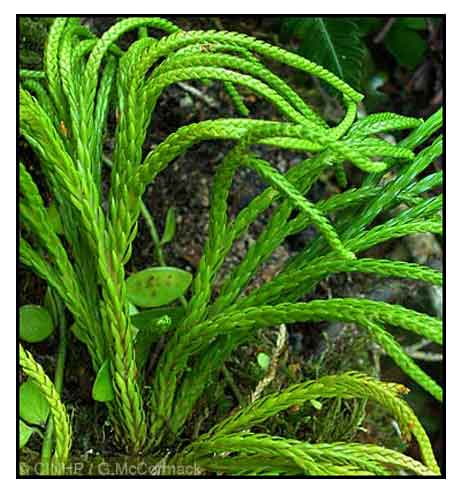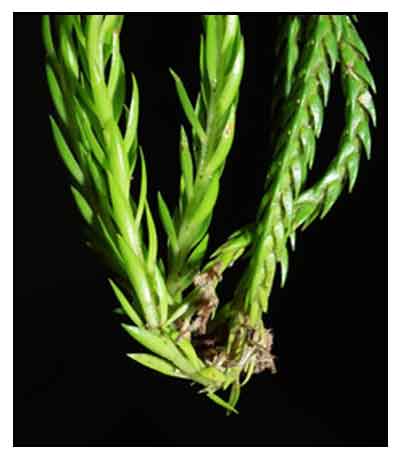
Family • Lycopodiaceae
Keeled clubmoss
Huperzia carinata (Desv. ex Poir.) Trevis
KEELED TASSEL FERN
Long gu ma wei shan
| Scientific names | Common names |
| Huperzia albescens (F.M.Bailey) Holub. | Carinata tassel fern (Engl.) |
| Huperzia carinata (Desv. ex Poir.) Trevis. | Keeled clubmoss (Engl.) |
| Huperzia laxa (C.Presl) Trevis.. | Keeled tassel fern (Engl.) |
| Huperzia struthioloides (C.Presl) Rothm. | |
| Huperzia vanikorensis (Copel.) Holub. | |
| Lycopodium albescens F.M.Bailey | |
| Lycopodium carinatum Desv. | |
| Lycopodium carinatum var. minus Tagawa | |
| Lycopodium laxum C.Presl | |
| Lycopodium truthioloides C.Presl | |
| Lycopodium urostachyum Wall. | |
| Lycopodium vanikorense Copel. | |
| Phlegmariurus carinatus (Desv.) Ching | |
| Phlegmariurus laxus (C.Presl) Satou | |
| Selaginella struthioloides Underw. | |
| Urostachys carinata (Desv.) Herter ex Nessel | |
| Urostachys struthioloides (C.Presl) Herter ex Nessel | |
| Huperzia carinata (Desv.) Trevis. is an accepted name. KEW: Plants of the World Online | |
| Other vernacular names |
| CHINESE: Long gu ma wei shan. |
| INDONESIAN: Kumpai lubang. |
| THAI: Hang nu Hang pia check, Soi nari. |
Botany • Lycophytes, medium-sized. Stems caespitose, mature branches pendulous, 1 to several times forked, 31-49 cm, branches slightly robust, stem together with leaves cordlike, tertiary branches with leaves more than 2.5 mm in diam., lateral branches unequal. Leaves twisted and forming 2 rows. Trophophylls dense, adnate to branches, much incurved, lustrous, acicular, up to 8 × 4 mm, midrib indistinct, hard, raised abaxially and keeled, base cuneate, decurrent, sessile, margin entire, apex acuminate, substraight, opening outside. Strobili terminal on branches, ca. 3 mm in diam. Sporophylls ovate, midrib indistinct, base cuneate, margin entire, apex acute, with mucro. Sporangia hidden inside of sporophylls, indistinct, yellowish, reniform, vertically bisected. (Flora of China)
Constituents Properties Studies Availability |
Updated July 2024
August 2020
![]()
 |
| PHOTOS / ILLUSTRATIONS |
| IMAGE SOURCE: Photograph / Huperzia carinata / © Cheng-Wei CHEN / click on image to go to source page / Flora of Solomon Islands |
| OTHER IMAGE SOURCE: Photograph / Keeled clubmoss: Huperzia carinata / © Geral McCormack / Cook Islands Biodiversity Database / Cook Islands Natural Heritage Trust , Rarotonga / click on image to go to source page / Cook Islands Biodiversity & Natural Heritage |
Additional
Sources and Suggested Readings |
α•(5) |
DOI: It is not uncommon for links on studies/sources to change. Copying and pasting the information on the search window or using the DOI (if available) will often redirect to the new link page. (Citing and Using a (DOI) Digital Object Identifier) |
| List of Understudied Philippine Medicinal Plants |
| New plant names needed The compilation now numbers over 1,500 medicinal plants. While I believe there are hundreds more that can be added to the collection, they are becoming more difficult to find. If you have a plant to suggest for inclusion, native or introduced, please email the info: scientific name (most helpful), local plant name (if known), any known folkloric medicinal use, and, if possible, a photo. Your help will be greatly appreciated. |
α•(5) |
 |



